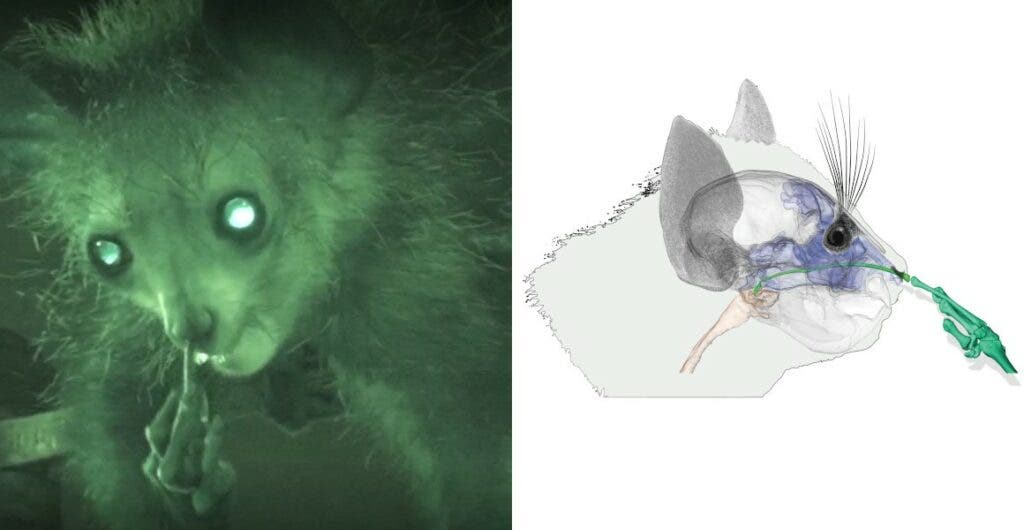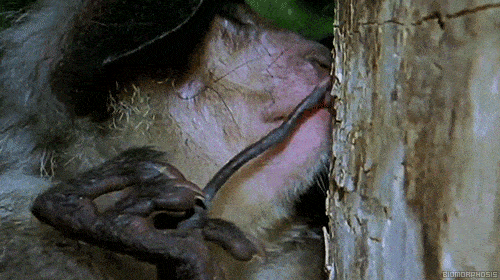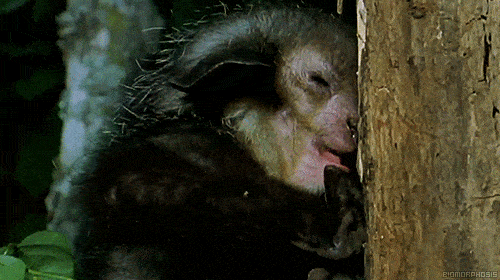
Although picking one’s nose is deemed rude and socially unacceptable in most cultures, virtually everyone has done it at least once. But for such a prevalent behavior, scientists are still at odds as to why exactly humans do it. Clues may be found in nature as biologists have found that, besides humans, 11 other primates are also known to pick their noses. These include chimpanzees, macaques, gorillas, and most recently a rare species of lemur from Madagascar known as the aye-aye.
Aye-ayes (Daubentonia madagascariensis) have dark brown or black fur and are distinguished by a bushy tail that is larger than their body. They look a lot like gremlins with their big, penetrating eyes, large sensitive ears, and very long and slender fingers. It has six digits, including a tiny pseudothumb that helps it grip branches and an elongated, 8-centimeter long middle finger that the primate makes good use of by tapping trees for wood-boring insect larvae moving under the bark. It employs the same middle finger to fish them out.


Now, imagine the shock felt by Dr. Anne-Claire Fabre, the curator of mammals at the Natural History Museum of Bern in Switzerland when she witnessed a captive aye-aye use that same super-long finger to pick its nose.
Fabre later recruited colleagues and embarked on a study in which they used CT scans to reveal how deep inside the aye-aye’s finger was boring through its nose. Turns out the finger is so long that it passes through the entire nasal passage, ending all the way at the esophagus.
“When I first saw this video, I was really struck by the nose picking,” Roberto Portela Miguez, senior curator in charge of mammals at the Natural History Museum in London said in a press release. “I’ve never heard of anything like it before outside of humans. It’s a surprise because aye-ayes are quite an iconic species, so you would think it would have been reported somewhere before now.”
“We were in for an even bigger surprise when we used CT scanning to see how the nose picking works internally, and the scan was mind-blowing. We were shocked from the reconstruction that the aye-aye’s finger could reach through its nose almost to the back of its throat.”
The study published in the Journal of Zoology could not put its finger on exactly why the aye-aye engages in this all too familiar nose-picking behavior, formally known ‘rhinotillexis’. Perhaps it serves to scratch an itch or irritation and the consumption of the snot may provide nutritious benefits. Bacteria in the mucus may also confer an immunity boost.
What’s clearer is that not all that many animals do it, and all who do have one thing in common: they all have highly dexterous digits. It’s a bit difficult to pick your nose with hooves. Rhinotillexis has been recorded in great apes, as well as in Old and New World monkeys, which suggests nose picking may serve an evolutionary function, though the researchers are cautious not to jump to any conclusions from a study of only 12 species.
“We don’t even know if it’s limited to primates. We would need a much larger sample to make any conclusions about that, and it would be nice if this paper could kick off research into this topic,” Dr. Anne-Claire said, adding that “Disgusting habits such as coprophagy (eating poo) have a lot of studies devoted to them, so there’s no reason why nose picking and snot eating shouldn’t be studied as well.”
These findings come right in the nick of time, serving to draw much-needed attention to the gentle aye-aye, which is critically endangered. Malagasy people don’t think of it too fondly, finding the aye-aye’s bizarre appearance frightening. According to ancient Malagasy legends, the aye-aye is considered a symbol of death. The natives believe if an aye-aye ever points its middle finger at you, then death will surely soon befall. For this reason, the poor aye-ayes are often killed on sight by superstitious locals. Due to this persecution, as well as habitat loss, fewer than 1,000 individuals are left in the wild. Somewhere in Madagascar’s rainforest, an angry aye-aye must be taking a break from ant farming to raise that middle finger up in the air.
Was this helpful?



